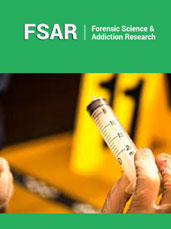- Submissions

Abstract
Forensic Science & Addiction Research
Graphene’s Role in Forensics: Enhancing Accuracy in Crime Investigations
-
Open or CloseMuhammad Ali Raza1, Muhammad Sheraz2, Ali Umar3, Memoona Ghulam Rabbani1, Maryyum Amin1, Fazilat Amna1, Shehla Honey4 and Misbah Ullah
Khan4*
1Department of Biochemistry, University of Okara, Okara 56130, Pakistan
2University Law College, University of The Punjab, Lahore, Pakistan
3Department of Zoology, Faculty of Life Sciences, University of Okara, Okara 56130, Pakistan
4Center for Nano Sciences, University of Okara, Okara 56130, Pakistan
*Corresponding author:Misbah Ullah Khan, Center for Nano Sciences, University of Okara, Okara 56130, Pakistan
Submission: June 04, 2024;Published: July 01, 2024

ISSN: 2578-0042Volume6 Issue3
Abstract
Nanotechnology, on its part, is at the cutting edge in forensic science and leading the revolution of approaches groundbreaking in crime investigation. This paper has been researched in an intense manner so as to discover the wide range of applications that nanotechnology has accrued within the domain of forensic analysis. These range from important spheres, including questioned documents examination, bloodstain ageing and estimation of post-mortem interval, as well as DNA profiling, explosive detection and identification of illicit drugs. With nanotechnologically based approaches, the efficiency and precision of forensic instruments are therefore dramatically increased, thereby proving that credible results can be provided within a significantly lesser amount of time. Remarkably, the discovery of graphene an exclusive two-dimensional carbon material, well known for its unequaled qualities by any other material is but a great potential. Capabilities of graphene come to the fore in bio-sensing, at levels of sensitivity and accuracy particularly for DNA detection that can be described as never seen before, due to its unique characteristics. In turn, this means that the general potential of nanotechnology carries its repercussions for the development of forensic analysis, both in its effectiveness and in its progress. It gives the researcher revolutionary instruments that enable him to solve riddles and make definite and reliable judgments, shaping a future where forensic science leads to more clarity and a sort of justice that finds no parallel.
Keywords:Nanotechnology; Forensic science; Crime investigation; Bloodstain age determination; Graphene; Magnetic nanoparticles; AFM; Bio sensing; Dependable outcomes; Novel techniques
 a Creative Commons Attribution 4.0 International License. Based on a work at www.crimsonpublishers.com.
Best viewed in
a Creative Commons Attribution 4.0 International License. Based on a work at www.crimsonpublishers.com.
Best viewed in 







.jpg)






























 Editorial Board Registrations
Editorial Board Registrations Submit your Article
Submit your Article Refer a Friend
Refer a Friend Advertise With Us
Advertise With Us
.jpg)






.jpg)














.bmp)
.jpg)
.png)
.jpg)










.jpg)






.png)

.png)



.png)






